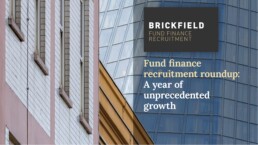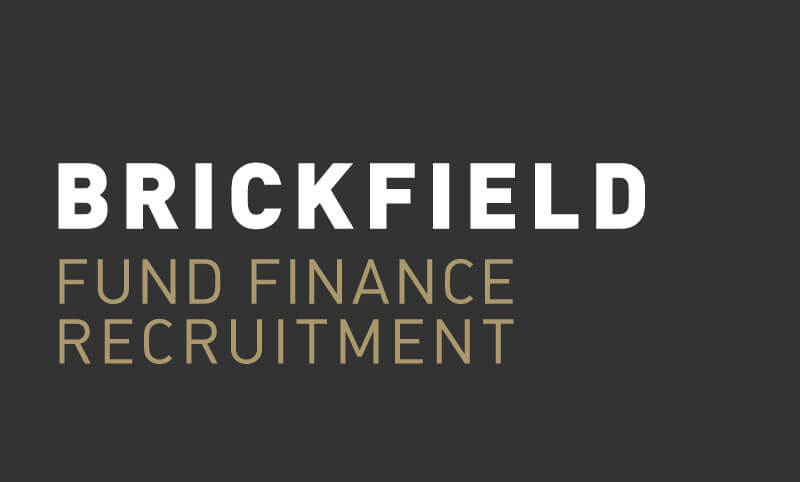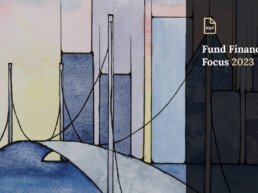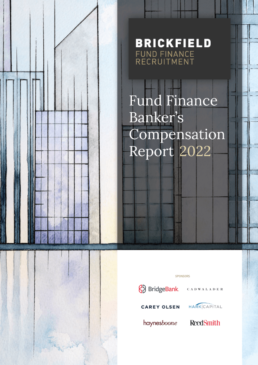Fund finance recruitment roundup: A year of unprecedented growth

Global overview
2022 has been a year of change in the fund finance world when it comes to recruitment and team-building. Brickfield facilitated more moves than ever before as the market roared back from the disruptions of 2020 and 2021, and navigated many clients through some new challenges, especially the increase in demand and interest from the buy side as they built their treasury and fund finance operations. This contributed significantly to increased compensation levels across the board, due to intense competition for the acquisition of talent from a limited pool.
The lenders and law firms we interviewed for this article agree unanimously that these challenges have resulted in some very positive outcomes, with many feeling in better shape than they were at the beginning of 2021, which stands them in a potentially strong position to weather what looks like a more unpredictable year in 2023.
Hiring activity
Almost every fund finance operation around the world has seen significant internal change and expansion in the last year, with senior-level appointments seeing a particular spike. Reed Smith’s story here is a particularly notable one, with the arrival this year of two new US fund finance partners, a new UK fund finance counsel, and no less than seven new fund finance specialist associates in the US. “It was initially a challenge but then as we started to grow the US team recruitment became easier and easier as potential candidates could see what we were putting together,” says Leon Stephenson, co-head of Reed Smith’s fund finance team. “I guess the message is that once you have a clear strategy and generate momentum with your hiring, things start to fall into place.”
In Asia, a market that has not yet boomed in the way it has in the US and Europe, we have seen significant hiring activity, with Brickfield appointing Chris Jasper earlier this year as our EMEA and APAC specialist to help our clients there meet hiring demands.
Danielle Roman, local practice leader of Mourant Ozannes’ banking and finance team, says recruitment levels have been high for the last 18 months, and attraction and retention remain a key focus for the firm. “Like many other firms in APAC, a combination of the impact of COVID and the competition for talent has led to a challenging recruitment period that doesn’t seem to be slowing down,” she explains. “As a result of the zero-Covid policies adopted in China and Hong Kong over the past three years, we have seen some flight of talent out of Hong Kong into Singapore, though as Hong Kong slowly starts to open back up, we are starting to see the return of that talent back into Hong Kong.”
The expansion experienced by law firms has of course been driven by increased lending activity, as well as the diversification of products now on the market. Steve Burton, treasurer at the Intermediate Capital Group, says: “We see the tendency towards inhouse resource increasing, as asset managers establish fund finance across multiple strategies and products – NAV and leverage deals now actually being done. The challenge ahead will be to embed the team and further deepen relationships with our Lawyers and banking group to build efficiency.”
in addition to external recruitment, sourcing new talent from within has been also a focus for many, especially at larger banks. Russell Evans, head of financial institutions, Europe at National Australia Bank, tells us: “Our most recent recruitment has been internally focused in an effort to develop our own institutional talent and enable career development and upward succession within the business as we continue to grow.”
The market outlook for 2023
Despite the war in Ukraine and the costs of the pandemic impacting already fragile economies, optimism remains high among lenders and law firms, who all report that there is still a great deal of interest and activity in subscription finance. Lenders are behaving more cautiously these days, but they are still open for business. Mid-tier syndication is becoming more difficult because the pool of lenders has shrunk, and lenders are becoming more selective, especially with funds outside the top tier.
The news is not all bad, however. “Activity remains high whatever the macro backdrop, the challenges just change a little,” says Steve Burton at the Intermediate Capital Group, who adds that deals tend to take longer to arrange and to document, with a higher due diligence bar. “More time is now needed on building new relationships. I see this trend continuing over the coming 12 months, the extent to which this happens will be dependent on how banks adapt their lending models.”
Matthias Jahnke, managing director – fund finance at Wells Fargo, says we are closely following market supply, which continues to be increasingly curtailed, while demand continues to be elevated following years of low interest rates, “a dynamic which we think will persist into 2023 until central banks around the globe start to taper contractionary monetary policies.”
NAV and ESG were undoubtedly the industry’s acronyms of 2022, especially in the first half of the year. According to Steve Burton, “the focus soon shifted to interest rates and latterly market capacity as the macro backdrop and regulatory requirements – particularly in the US – and FX impacted the supply side. In addition, capital deployment and realisations across the alternatives sector slowed.”
Reed Smith’s Leon Stephenson, whose team focuses significantly on NAV and coinvest facilities, is however seeing these areas now develop “at lightning speed”. The firm has yet to see any negative impact resulting from the ongoing global challenges, Stephenson says, “and we expect our business to continue to shift from capital call facilities to NAV and coinvest facilities next year as fund raising levels out and liquidity needs increase”.
Danielle Roman at Mourant Ozannes in Hong Kong is similarly expecting more of a shift in focus than a slowdown per se. “We do not predict less appetite in the region, rather we will have clients asking us about managing risks to ensure best rewards for their use of capital,”she says. “We expect to see an uptick in restructuring work, continued growth in private credit transactions and clients looking out for opportunities in a down-market in hope for big rewards when the market returns.”
Evans at National Australia Bank meanwhile sees opportunity in the challenges ahead. “We’re expecting the economic slowdown to continue driving greater innovation across the product, with managers seeking bespoke solutions that can provide liquidity to continuation vehicles and fully invested funds via asset recourse.”
An interesting hiring market ahead
This shift in the fund finance market towards more nuanced structures built for a lower-risk, higher interest rate market means that 2023 will be a year for the rainmakers – the people who have a full Rolodex and are willing to get out there and forge new relationships and create new solutions collaboratively. Alternative lenders will also undoubtedly grow in significance over the next year, and this will make for an interesting narrative in terms of how traditional lenders react to the new entrants, especially those with alternative sources of capital who are more keen on growth.




